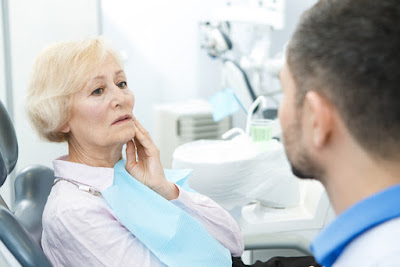What Is Temporomandibular Joint Dysfunction?
Dysfunction of muscles of mastication and temporomandibular joints is typically called as temporomandibular joint dysfunction or temporomandibular joint dysfunction syndrome (TMJ), a collective term which represents a diverse group of pathologies involving temporomandibular joints, the muscle of mastication or both.
Muscles of mastication are the muscles that move the jaw, and temporomandibular joints are the joints which connect the mandible (lower jaw or jaw bone) to the skull.
This syndrome causes pain and also limits the mandible movement. Noises from the temporomandibular joints, during jaw movement, are heard from the patients suffering from the dysfunction.
 |
| Temporomandibular Joint Dysfunction Or Temporomandibular Joint Dysfunction Syndrome |
Even though the syndrome is not hazardous, the quality of life is adversely affected because this disease's symptoms can become chronic and difficult to manage and hence no irreversible treatment should be carried out for TMJ.
TMJ is accepted to be the second most frequent cause of orofacial pain where the dental pain is considered to be the first. The dysfunction is generally found in the people of age between 20 and 40 years and females are more likely to be suffering from the dysfunction. However, only 20% to 30% of the adult population is affected to some degree.
TMD Also Causes
- Burning mouth syndrome.
- Atypical facial pain.
- Atypical odontalgia.
Based on the duration, TMD is classified into acute TMD (symptoms last for less than three months) and chronic TMD (symptoms last for more than three months).
Causes Of TMD
TMD is a complex condition rather than a single condition. Multiple factors cause TMD like predispose factors (genetic, hormonal, and anatomical), factors that precipitate it (trauma, occlusal changes, parafunction) and factors which prolong it (stress, parafunction).
The areas of the bones that interact in the temporomandibular joint are covered with cartilage and are separated by the small shock-absorbing disc which when moves out of its proper alignment, i.e., misalignment causes TMD.
Other Causes Include:
- Damage of cartilage of the joint, by arthritis, is also a cause of TMD.
- Trauma such as a blow or any other impact that damages the joint.
Factors That Increase The Risk Of TMD
- Rheumatoid arthritis, osteoarthritis, and other inflammatory musculoskeletal disorders.
- Jaw injury.
- Grinding and clenching of teeth during sleep, excessive gum chewing.
- Connective tissue diseases, dental surgery infections which may affect the temporomandibular joint and leads to TMD.
- Stress or anxiety, autoimmune diseases.
- Poor posture.
- Orthodontic braces.
- Typically violinists have been noted to be encountered with TMD at a higher rate than the general population, as their work involves holding an instrument under the jaw.
Symptoms Of TMD
- As mentioned above pain is the first symptom observed in the patient, a pain that is felt when moving the jaw.
- Headaches or migraines, neck aches or back aches and ear aches or pain around the ear that spreads to the cheeks are the other symptoms looked for by the doctors, before diagnosing a TMD.
- The painless symptom which is observed is usual popping, clicking or even grinding noise. This noise is heard while eating, talking or opening the mouth. These symptoms alongside pain need medical attention.
- Buzzing, ringing or numbness in the ears alongside earaches is also associated with TMJ.
 |
| Jaw Pain Is A Sign Of TMD |
TMD Prevention
The occurrence or the recurrence of TMD may be avoided using the following preventive measures:
- Excessive gum chewing must be avoided.
- Biting pencils, pen caps, fingernails, and cuticles are the bad habits found in 80% of the population which must be strictly avoided.
- Avoid the foods that are too difficult to chew.
- Massage the muscles to get relief from stress and learn other relaxation techniques to reduce muscle tension.
- Have a sound sleep.
- Proper posture maintenance while sleeping, standing and sitting.
- Avoid the same position throughout the day.
- Stretch periodically to relieve repetitive stress on the body.
TMD Treatment
Different treatments, often more than one is needed to be done at the same time.
- Treatment of pain through pain relievers and anti-inflammatories: non-steroidal anti-inflammatory drugs (NSAIDs) such as ibuprofen (Advil, Motrin IB, others) are often recommended for stronger pain.
- Dr. Roman Fedorciw, an expert Middletown dentist, highly recommends many ways of treating TMD, ranging from non-invasive therapy and bite splints to injections or surgery.
- Treatment might include ultrasound, moist heat and ice-along with exercises to stretch and strong jaw muscles.
- Arthrocentesis, injections (botulinum toxin type A), TMJ arthroscopy, modified Condylotomy, open-joint surgery are some of the surgical procedures often practiced by doctors.
In some cases self-care and lifestyle changes may be enough; hence education and counseling can be helpful.




No comments:
Post a Comment